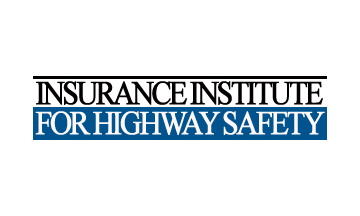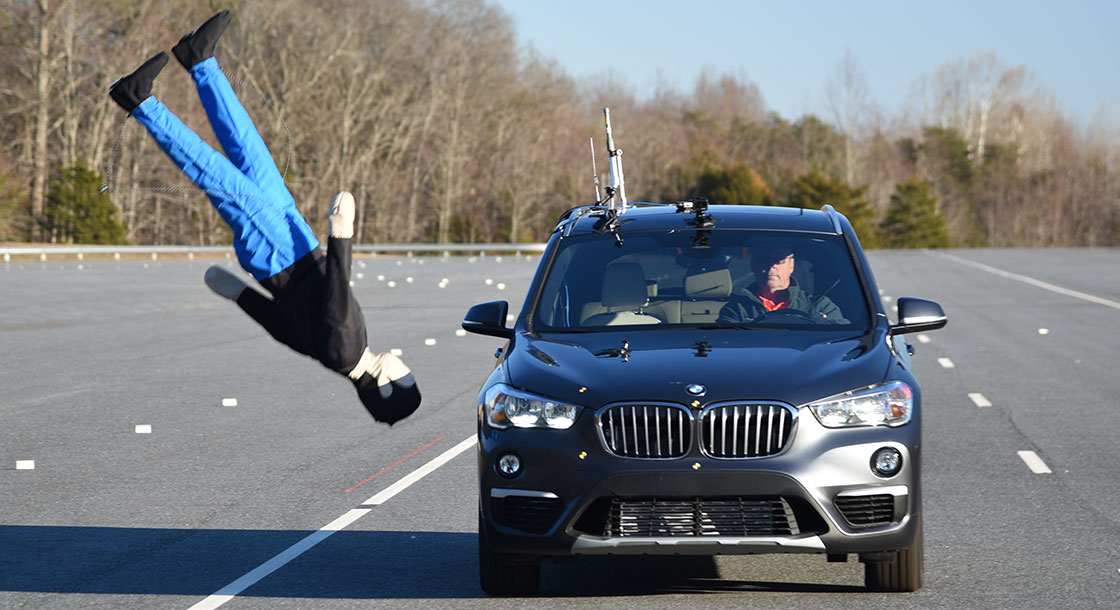IIHS - New ratings address pedestrian crashes
 |
Reducing pedestrian crashes is the goal of new IIHS ratings of automatic emergency braking systems that can detect and brake for people on foot. In the first tests of 2018–19 vehicles with this crash avoidance feature, 9 of 11 small SUVs evaluated earn an advanced or superior rating for pedestrian crash prevention.
The 2018–19 Honda CR-V, 2019 Subaru Forester, 2019 Toyota RAV4 and 2019 Volvo XC40 earn the highest rating of superior. Five models earn an advanced rating. They are the 2019 Chevrolet Equinox, 2018–19 Hyundai Kona, 2019 Kia Sportage, 2018–19 Mazda CX-5 and 2019 Nissan Rogue. The 2019 Mitsubishi Outlander is rated basic, and the 2018–19 BMW X1 doesn't receive any credit for a rating. Pedestrian detection is standard on the Forester, RAV4, Rogue, X1 and XC40.
The ratings come amid renewed focus on the problem of crashes involving pedestrians. Pedestrian deaths have risen 45 percent since reaching their lowest point in 2009 (see "On foot, at risk: Study highlights rising pedestrian deaths, points toward solutions," May 8, 2018). In 2017, 5,977 pedestrians died in crashes in the U.S., down 2 percent from 2016, which marked the most deaths since 1990.
The ratings come amid renewed focus on the problem of crashes involving pedestrians. Pedestrian deaths have risen 45 percent since reaching their lowest point in 2009. In 2017, 5,977 pedestrians died in crashes in the U.S., down 2 percent from 2016, which marked the most deaths since 1990.
Autobrake systems that can detect and brake for pedestrians are one important countermeasure to address the problem.
A 2018 HLDI analysis found that Subaru's EyeSight system with pedestrian detection cut the rate of likely pedestrian-related insurance claims by 35 percent, compared with the same vehicles without the system (see "Subaru crash avoidance system cuts pedestrian crashes," May 8, 2018).
A 2018 HLDI analysis found that Subaru's EyeSight system with pedestrian detection cut the rate of likely pedestrian-related insurance claims by 35 percent, compared with the same vehicles without the system.
In general, pedestrian detection systems use a forward-facing mono camera or stereo cameras mounted near the rearview mirror plus radar sensors in the vehicle's front grille to continuously scan the roadway and horizon for pedestrians and, in some cases, bicyclists or animals, who might cross the vehicle's travel path. Algorithms classify the objects as people, bicyclists or animals, predict their travel path and determine the vehicle's speed in relation to them. If a collision is imminent, the system typically alerts the driver and can apply the brakes far faster than a human could react.
The pedestrian autobrake test is the fourth crash avoidance evaluation in the Institute's quiver of safety tests. IIHS began rating front crash prevention systems in 2013, headlights in 2016, and rear crash prevention systems in 2018. Under the new program, vehicles rate as basic, advanced or superior, based on their ability to avoid or mitigate a crash with pedestrian dummies in three different test track scenarios run at different speeds. The Institute shared the test protocol with manufacturers in fall 2018 (see "IIHS prepares to test pedestrian detection systems," Dec. 19, 2018).
The pedestrian autobrake test is the fourth crash avoidance evaluation in the Institute's quiver of safety tests. IIHS began rating front crash prevention systems in 2013, headlights in 2016, and rear crash prevention systems in 2018. Under the new program, vehicles rate as basic, advanced or superior, based on their ability to avoid or mitigate a crash with pedestrian dummies in three different test track scenarios run at different speeds. The Institute shared the test protocol with manufacturers in fall 2018.
Pedestrian deaths in crashes involving motor vehicles, 1975-2017
Crash scenarios
The tests address three common pedestrian crash scenarios.
"The first scenario involves an adult pedestrian on the right side of the road entering the street in the path of an oncoming vehicle. This is the most common type of crash involving a pedestrian," explains David Aylor, the Institute's manager of Active Safety Testing.
"The second test simulates a child darting into the street from behind two parked vehicles. As a dad, I know this is every parent's nightmare," Aylor says.
"The third test scenario replicates an adult walking in the vehicle's travel lane near the edge of the road. The adult's back is turned away from traffic."
Vehicles are scored according to their average speed reductions in five repeated test runs on dry pavement. Tests are conducted at 12 mph and 25 mph in the perpendicular adult and child scenarios, and at 25 mph and 37 mph in the parallel adult scenario.
The four superior-rated and five advanced-rated SUVs had significant speed reductions in every scenario. That meant the SUVs almost avoided and, in some cases, did avoid striking the pedestrian dummies.
"The best possible outcome is to avoid hitting a pedestrian altogether," Aylor says. "When a crash is unavoidable, sharply reducing a vehicle's travel speed would give someone on foot a far greater chance of surviving any injuries in a similar real-world encounter with a passenger vehicle."
When seconds count
The most challenging test is the perpendicular child scenario. The 45-inch-tall dummy, which represents an average-size 7 year-old, is hidden by a car and an SUV parked on the right side of the road as the test vehicle approaches. There is no clear line of sight for the camera until the dummy emerges from behind the parked vehicles when the test vehicle is about 2 seconds, or 35 feet, away in the 12 mph test or just under 2 seconds, or 65 feet, away in the 25 mph test. When the dummy enters the travel lane, the test vehicle is roughly 1.5 seconds away.
In the 12 mph perpendicular adult test, the vehicle is about 1 second, or 20 feet, away when the 6-foot-tall pedestrian dummy enters the travel lane, and in the 25 mph test, the vehicle is about 1 second, or 45 feet, away when the pedestrian enters the travel lane.
"It would be hard for human drivers to react quickly enough to brake in time if they didn't see the pedestrian until he or she was already in the road," Aylor says.
Only the Forester and RAV4 avoided hitting the dummies in every perpendicular test. The XC40 avoided the adult dummy in the 12 mph and 25 mph tests and avoided the child dummy in the 12 mph test.
IIHS gives credit in the 37 mph parallel adult test to systems that issue a timely warning (greater than or equal to 2.1 seconds time-to-collision), upping the odds of a driver response. The CR-V and Forester are the only small SUVs in the group to earn credit for issuing a warning in the parallel adult test before automatically braking to mitigate the impact with the dummy.
The Outlander's autobrake system mitigated its speed by about 19 mph in the 25 mph parallel adult test and by 11 mph in the 12 mph perpendicular child test. The Outlander managed only minimal speed reductions in the other tests, despite earning a superior rating for front crash prevention in tests of its ability to avoid or mitigate collisions with other vehicles.
The X1, which comes with BMW's Daytime Pedestrian Detection system, didn't brake at all in the 37 mph parallel adult scenario. The luxury SUV had minimal to no speed reductions in the other tests. In front crash prevention tests, the X1 is rated advanced.
IIHS has a twofold aim in adding pedestrian crash prevention ratings to its test mix.
"We want to encourage manufacturers to include pedestrian detection capabilities as they equip more of their vehicles with automatic emergency braking systems," Aylor says. "We also want to arm consumers with information about these systems so they can make smart choices when shopping for a new vehicle."
A 2011 IIHS analysis of 2005–09 crash data estimated that pedestrian detection systems could potentially mitigate or prevent up to 65 percent of single-vehicle crashes with pedestrians in the three most common crash configurations and 58 percent of pedestrian deaths in these crashes if all vehicles were equipped with the systems (see "Pedestrians stand to benefit from new vehicle technology and designs," March 30, 2011).
A 2011 IIHS analysis of 2005–09 crash data estimated that pedestrian detection systems could potentially mitigate or prevent up to 65 percent of single-vehicle crashes with pedestrians in the three most common crash configurations and 58 percent of pedestrian deaths in these crashes if all vehicles were equipped with the systems.
Roughly two-thirds of front crash prevention systems offered on 2019 models have pedestrian detection capabilities. Many of these also can detect and react to bicyclists and, in some cases, animals, although IIHS didn't assess these capabilities.
How small SUVs rate in new pedestrian test
Vehicles rate as basic, advanced or superior, based on their ability to avoid or mitigate a crash with pedestrian dummies in three different test track scenarios run at different speeds.
 Superior Superior |
|---|
| 2018-19 Honda CR-V |
| 2019 Subaru Forester |
| 2019 Toyota RAV4 |
| 2019 Volvo XC40 |
 Advanced Advanced |
|---|
| 2019 Chevrolet Equinox |
| 2018-19 Hyundai Kona |
| 2019 Kia Sportage |
| 2018-19 Mazda CX-5 |
| 2019 Nissan Rogue |
 Basic Basic |
|---|
| 2019 Mitsubishi Outlander |
 No credit No credit |
|---|
| 2018-19 BMW X1 |

The X1, which comes with BMW’s Daytime Pedestrian Detection system, didn’t brake at all in the 37 mph parallel adult test, sending the dummy airborne. In the other tests, the luxury SUV didn’t slow in time to avoid hitting the dummies.


